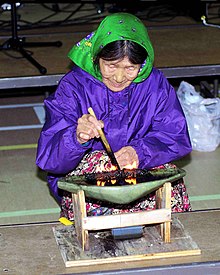This article has multiple issues. Please help improve it or discuss these issues on the talk page. (Learn how and when to remove these template messages)
|



The Inuit are indigenous people who live in the Arctic and subarctic regions of North America (parts of Alaska, Canada, and Greenland). The ancestors of the present-day Inuit are culturally related to Iñupiat (northern Alaska) and Yupik (Siberia and western Alaska),[1] and the Aleut, who live in the Aleutian Islands of Siberia and Alaska. The word "Eskimo" has been used to encompass the Inuit and Yupik, and other indigenous Alaskan and Siberian peoples,[2][3][4] but this usage is in decline.[5][6]
In Inuit communities, the women play a crucial role in the survival of the group. The responsibilities faced by Inuit women were considered equally as important as those faced by the men. Because of this, women are given due respect and an equal share of influence or power.[7]
Recent modernization and urbanization have transformed traditional Inuit culture and influenced the role of women within the culture. These changes include both positive and negative impacts on the overall well-being of Inuit women.[8]
- ^ "Inuit", Canadian Encycloprdia
- ^ "Eskimo | Definition, History, Culture, & Facts". Encyclopedia Britannica. 5 March 2024.
- ^ "Why You Probably Shouldn't Say 'Eskimo'". NPR. Retrieved 2021-04-01.
- ^ "Eskimo: Websters Dictionary". Retrieved 1 April 2021.
- ^ Kaplan, Lawrence. "Inuit or Eskimo: Which name to use?". Alaska Native Language Center, University of Alaska Fairbanks. Retrieved 2021-04-01.
- ^ "Expert says 'meat-eater' name Eskimo an offensive term placed on Inuit". Retrieved 2021-04-01.
- ^ Cite error: The named reference
Billsonwas invoked but never defined (see the help page). - ^ Cite error: The named reference
McElroywas invoked but never defined (see the help page).
